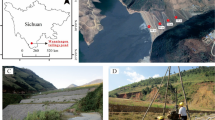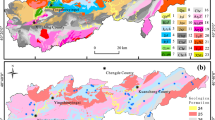Abstract
The Emeishan basalt has a high Cu background value (170×10−6 on average), and thus provides a ore-forming material source for copper ores. The collected samples were exposed in basalt lavas of the third segment of the Emeishan basalt eruptive cycle. By using a set of automatically cycling glass apparatuses, weathering-leaching experiments by three kinds of rainwater on the collected samples were carried out in the open system (at normal temperature and normal pressure). The analysis results showed that the most intensive export of Cu occurred under acidic rainwater-induced weathering-leaching conditions, almost 2–3 orders of magnitude the export of Cu by modern air rainwater, and 1–2 orders of magnitude higher than the export of Cu by CO2 rainwater. In addition, the total amount of Zn, Cu, U, Ni and Sr exported by acidic rainwater are greater than 1%. All this indicates that copper in the Emeishan basalt provided the copper source for Cu mineralization at the contact between the basalt and the Maokou Formation limestone at the bottom.
Similar content being viewed by others
References
Boven A., Pasteels P., Punzalan L.E. et al. (2002) 40Ar/39Ar Geochronological constrains on the age and evolution of the Permo-Triassic Emeishan volcanic province, Southwest China [J]. J Asian Earth Sciences. 20, 157–175.
Chen Fu and Zhu Xiaoqing (1987) Study on the evolution of supergene weathering-leaching and the capability to provide ore-forming materials to sedimentary ore deposits [J]. Geochimica. (4), 341–350 (in Chinese with English abstract).
Chen Wenyi, Wang Zhonggang, and Liu Jiaren (2003) Permian lithofacies paleogeography of Guizhou and its relations to sedimentary ore resources [J]. Acta Paleogeographica Sinica. 5, 17–27 (in Chinese with English abstract).
Cheng Fu and Zhu Zioaqing (1984) Modeling experiment on banded Fe-Si formation resultant from paleo-weathering-leaching of basalts [J]. Geochimica. (4), 342–349 (in Chinese with English abstract).
Guizhou Provincial Bureau of Geology and Mineral Resources (1990) Guizhou Regional Geology [M]. pp.531. Geological Publishing House, Beijing (in Chinese).
Guo Feng, Fan Weiming, Wang Yuejun et al. (2004) When did the Emeishan Mantle Plume activity start? Geochronological and geochemical evidence from ultramafic-mafic dikes in southwestern China [J]. International Geology Review. 46, 226–234.
Lo Chinghua, Chung Sunlin, Lee Tungyi, and Wu Genyao (2002) Age of the Emeishan flood magmatism and relations to Permian-Triassic boundary events [J]. Earth Planet. Sci. Lett. 198, 449–458.
Mao Jingwen, Wang Zhiliang, Li Houmin et al. (2003) Carbon isotopes of copper deposits in the Permian basalts of the Ludian area, Yunnan Province and their significance in indicating metallogenesis [J]. Geological Review. 49, 610–615 (in Chinese with English abstract).
Mahoney J.J. and Coffin M.L. (1997) Igneous Province: Continental, Oceanic, and Planetary Flood Volcanism [M]. AGU Geophysical Monography. 100, 438.
Xu Yigang, Chung Sunlin, Jahn Bor-ming, and Wu Genyao et al. (2001) Petrologic and geochemical constraints on the petrogenesis of Permian-Triassic Emeishan flood basalts in southwestern China [J]. Lithos. 58, 145–168.
Yunnan Provincial Bureau of Geology and Mineral Resources (1990) Yunnan Province Regional Geology [M]. Geological Publishing House, Beijing (in Chinese).
Zhang Qian, Zhu Xiaoqing, and Zhang Zhengwei (2006) Lead isotopic composition and lead source of the Tongchanghe basalt-type native copper-chalcocite deposit in Ninglang, western Yunnan, China [J]. Chinese Journal of Geochemistry. 25, 112–121.
Zhang Zhengwei, Cheng Zhandong, Zhu Bingquan et al. (2004) The studies on the specific strata of Emeishan basalts formation are relationship with the copper-mineralization [J]. Acta Geoscientica Sinica. 25, 503–508 (in Chinese).
Zhou Meifu, Malpas J., Song Xieyan et al. (2002) A temporal link between the Emeishan large igneous province (SW China) and the end-Guadalupian mass extinction [J]. Earth Planet. Sci. Lett. 196, 113–122.
Zhu Xiaoqing, Huang Yan, Zhang Qian, He Yuliang, and Zhu Chaohui (2005) A simulating experiment on the geochemical variation trend at the initial period of meteoric waters converting to underground waters and ore fluids [J]. Chinese Journal of Geochemistry. 24, 306–315.
Author information
Authors and Affiliations
Corresponding author
Rights and permissions
About this article
Cite this article
Wan, F., Zhu, X., Han, T. et al. Modeling experimental study on weathering-leaching of Emeishan basalt and its relation with metallogenesis. Chin. J. Geochem. 29, 212–216 (2010). https://doi.org/10.1007/s11631-010-0212-9
Received:
Accepted:
Published:
Issue Date:
DOI: https://doi.org/10.1007/s11631-010-0212-9




